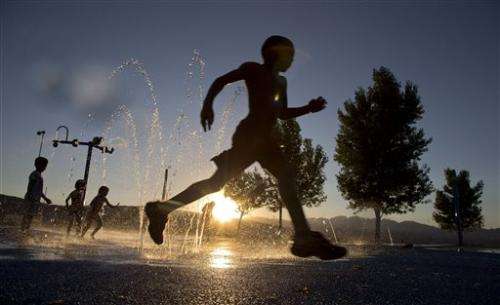US hottest spots of warming: Northeast, Southwest

The United States is warming fastest at two of its corners, in the Northeast and the Southwest, an analysis of federal temperature records shows.
Northeastern states—led by Maine and Vermont—have gotten the hottest in the last 30 years in annual temperature, gaining 2.5 degrees Fahrenheit (1.4 degrees Celsius) on average. But Southwestern states have heated up the most in the hottest months: The average New Mexico summer is 3.4 degrees Fahrenheit (1.8 degrees Celsius) warmer now than in 1984; in Texas, the summer days are 2.8 degrees Fahrenheit (1.5 degrees Celsius) hotter.
The contiguous United States' annual average temperature has warmed by 1.2 degrees Fahrenheit (0.7 degrees Celsius) since 1984. But that doesn't really tell you how hot it's gotten for most Americans. While man-made greenhouse gases warm the world as a whole, weather is supremely local. Some areas have gotten hotter than others because of atmospheric factors and randomness, climate scientists say.
"In the United States, it isn't warming equally," said Kelly Redmond, climatologist at the Western Regional Climate Center in Reno, Nevada. "Be careful about extrapolating from your own backyard to the globe."
For example, while people in the East and Midwest were complaining about a cold winter this year, Redmond's Nevada and neighboring California were having some of their warmest winter months ever.
To determine what parts of the country have warmed the most, The Associated Press analyzed National Climatic Data Center temperature trends in the lower 48 states, 192 cities and 344 smaller regions within the states. Climate scientists suggested 1984 as a starting date because 30 years is a commonly used time period and 1984, which had an average temperature, is not a cherry-picked year to skew a trend either way. The trend was calculated by the NCDC using the least squares regression method, which is a standard statistical tool.
All but one of the lower 48 states have warmed since 1984. North Dakota is the lone outlier, and cooled slightly.
Since 1984, 92 percent of the more than 500 cities and smaller regions within states have warmed and nearly two-thirds of them have warmed by at least a degree.
The Southwest warming, especially in the summer, seems to be driven by dryness, because when there is little water the air and ground warm up faster, said Katharine Hayhoe, a climate scientist at Texas Tech University in Lubbock.
And in the Northeast, the temperatures are pushed up by milder winters and warm water in the North Atlantic, said Kevin Trenberth, climate analysis chief at the National Center for Atmospheric Research. And less snow on the ground over the winter often means warmer temperatures, said Alan Betts, a climate scientist at Atmospheric Research in Pittsford, Vermont.
The Southeast and Northwest were among the places that warmed the least. In the Southeast and Mid-Atlantic, industrial sulfur particle pollutants from coal burning may be reflecting sunlight, thus countering heating caused by coal's carbon dioxide emissions, said Pennsylvania State University professor Michael Mann.
More information: The data came from National Climatic Data Center: www.ncdc.noaa.gov/cag/
© 2014 The Associated Press. All rights reserved.




















